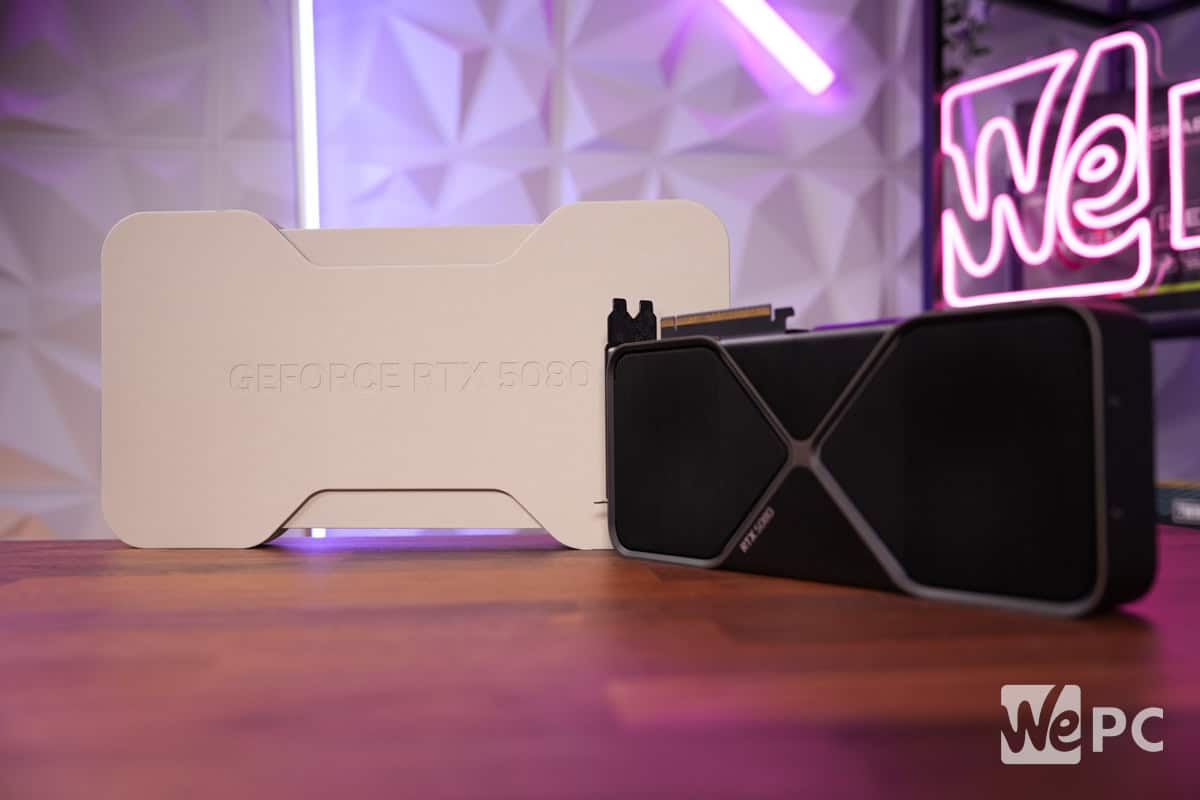
Check out our latest products
One of the best value GPUs we have seen from Nvidia
Updated: Jan 31, 2025 3:23 pm

WePC is reader-supported. When you buy through links on our site, we may earn an affiliate commission. Prices subject to change. Learn more
The long-anticipated Blackwell generation of Nvidia graphics cards has officially arrived, and with it comes the RTX 5080, part of the 50-series lineup. Building on the success of Ada Lovelace, Nvidia’s second-fastest 50-series promises massive improvements in performance, efficiency, and AI-driven enhancements. This review dives deep into the RTX 5080 Founders Edition, looking at its gaming performance and synthetic prowess to see if it lives up to its promise of being a game-changer in the high-end GPU space. It shouldn’t be too hard, given that AMD bowed out of this end of the market.
Of course, the big boy of the 50-series is the RTX 5090, but how good of an option is the RTX 5080, given its much lower price point? How much more does DLSS 4 offer than DLSS 3? Is the RTX 5080 a viable upgrade if you live outside the reach of DLSS? All questions that will be answered in this review. Let’s dive in.
RTX 5070 Ti launches today!
Nvidia’s latest Blackwell GPU is set to go live today, below are the latest listings from the biggest retailers.
Prices and savings subject to change. Click through to get the current prices.


Specifications
- Core clock speed: 2.30 GHz (Base) 2.62 GHz (Boost)
- CUDA Core: 10,752
- Memory: 16 GB GDDR7
- Memory speed : 30 Gbps
- Power connector: 12V-2×6
- TBP: 360W
What We Think
The RTX 5080 is arguably the best GPU we’ve seen—second only to the RTX 5090. Harnessing AI-powered performance, it delivers exceptionally high frame rates with ease. If you have a high-refresh-rate monitor and want to push serious FPS, this card offers strong value. At $1,000, it’s still a hefty investment, but considering how it outclasses the 4080 while launching at a lower MSRP, we’d say it’s worth it.
Reasons to Buy
- Incredible performance in DLSS 4-enabled games
- MFG facilitates unheard-of performance
- 2 slot card makes a nice change from 4
- Relatively cool thanks to re-designed cooling mechanisms
- looks sleek and stylish
Reasons to Avoid
- Rasterization performance uplift pales in comparison to DLSS and MFG performance.
- Strong focus on AI means you get less value if you only play games that cannot utilize DLSS.
- Still expensive
Specifications Overview
The RTX 5080 features significant upgrades across the board, including the next-gen Blackwell architecture, enhanced CUDA cores, and GDDR7 memory. Below is a comparison of key specifications:
| Specifications | RTX 5080 | RTX 4080 | RTX 4080 Super |
|---|---|---|---|
| GPU Architecture | Blackwell | Ada Lovelace | Ada Lovelace |
| CUDA Cores | 10,752 | 9,728 | 10,240 |
| Base Clock | 2.30 GHz | 2.21 GHz | 2.29 GHz |
| Boost Clock | 2.62 GHz | 2.51 GHz | 2.55 GHz |
| Memory | 16 GB GDDR7 | 16 GB GDDR6X | 16 GB GDDR6X |
| Memory Speed | 30 Gbps | 22.4 Gbps | 23 Gbps |
| Bandwidth | 960 GB/s | 716.8 GB/s | 736.3 GB/s |
| TDP | 360W | 320W | 320W |
| Power Connector | 12V-2×6 | 12V-2×6 | 12V-2×6 |
| MSRP | $999 | $1,199 | $1,199 |
At first glance, the specification differences don’t seem all that different. Still, things started to get interesting when discussing AI, Multi Frame Generation, and neural rendering. If you’re looking at the 5080 from a strict value position, note that the pure rasterization performance is nowhere near as strong as when assisted by AI, as we’ll get into later.
Design
From the outset, the RTX 5080’s design makes a strong impression, not just in aesthetics but in its unboxing experience as well. Nvidia has continued its push for sustainability by refining its packaging and cutting out plastics and foams in favour of recyclable cardboard. The result is a cleaner, more eco-friendly approach that still feels premium. The box itself follows the now-familiar Founders Edition presentation. Thick layers of cardboard secure the GPU, keeping it snug while minimising excess waste. Inside, the 5080 sits surprisingly compact, with just a small accessories box tucked underneath. No unnecessary extras, just the essentials.
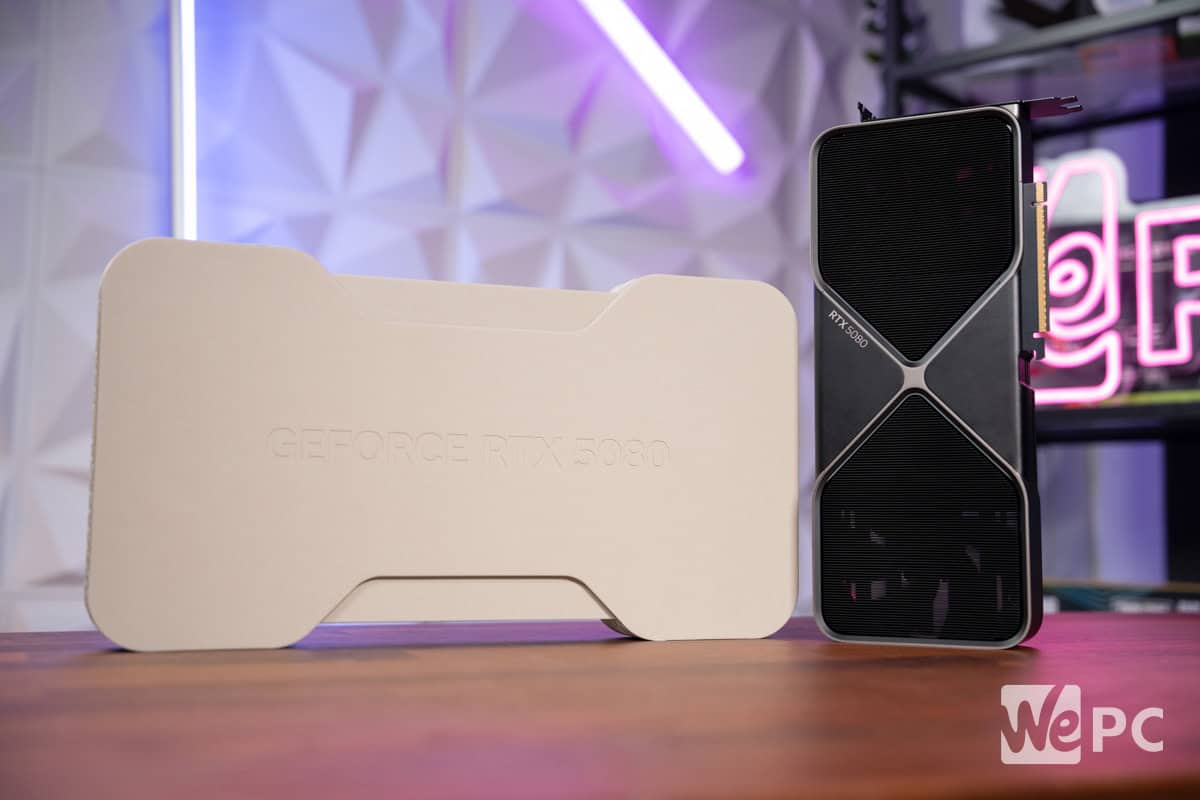

That compactness is one of the first things you notice about the RTX 5080. It’s considerably smaller than some of its predecessors, yet once you pick it up, the sheer weight becomes apparent. The dense build is a testament to Nvidia’s engineering, packing high-performance components and an advanced cooling solution into a much smaller footprint. Compared to some of the bulkier partner models from previous generations (like the ASUS ROG Strix RTX 4080), the 5080 Founders Edition feels almost minimalistic.
Visually, the Founders Edition retains Nvidia’s signature sleekness. The fan side sports a striking silver ‘X’ pattern over a black metal base, framing the dual-fan setup. The new PCB positioning also plays a key role in cooling, ensuring the best airflow from front to back. Air is efficiently pulled through the heatsink and out through the slightly recessed backplate, allowing for smooth heat dissipation. The result is a card that not only runs cooler but also does so while maintaining a refined, understated look.


Another major win is the improved power connector placement. The recessed and angled 12VHPWR connector means the often unwieldy adapter doesn’t protrude awkwardly, making cable management far less of a headache. Nvidia has also incorporated additional ventilation cutouts along the side, maximising airflow while keeping the design seamless. The illuminated GeForce RTX logo remains subtle, glowing in a clean white rather than anything overly aggressive.
Blackwell architecture and new features
The RTX 5080 debuts Nvidia’s Blackwell architecture, leveraging TSMC’s cutting-edge 4nm process to deliver more power-efficient performance. With a 360W TDP, the card squeezes more performance from its 10,752 CUDA cores while maintaining better thermal management than its predecessor.
One of the standout advancements in the RTX 5080 is the introduction of DLSS 4, which adds multi-frame generation capabilities. This innovation uses upgraded AI cores to analyze data from multiple frames, producing more accurate interpolations and further improving frame rates in supported games. Combined with the already stellar frame generation introduced in DLSS 3, Nvidia has raised the bar for AI-driven performance enhancements.


Additionally, the move to GDDR7 memory allows for a dramatic increase in memory bandwidth, jumping from 716.8 GB/s on the RTX 4080 to an impressive 960 GB/s on the RTX 5080. This provides smoother performance in 4K gaming and better efficiency in resource-intensive workloads.
Performance analysis
Regarding gaming performance, the Nvidia RTX 5080 establishes itself as a powerhouse, building on the already impressive foundation laid by its predecessor, the RTX 4080. Across a range of demanding titles, the RTX 5080 consistently delivers higher frame rates and smoother gameplay, particularly in scenarios where the additional power of DLSS 4 and multi-frame generation (MFG) come into play. While the raw performance uplift varies depending on the game and resolution, the RTX 5080 edges ahead of the RTX 4080 in most cases, making it an attractive upgrade for gamers seeking top-tier performance.
Before we jump right into the games, here’s the test bench we used to benchmark the 5080. It’s important to do this for transparency, as you might get different results at home, thanks to the hardware differences.
- Motherboard: ASUS ProArt X670E-CREATOR WIFI
- CPU: Ryzen 7 9800X3D
- RAM: Corsair Dominator Titanium RGB (64GB, 6600MT/s, CL32)
- CPU Cooler: ROG RYUJIN III 360
- PSU: 1000W Phanteks
- Windows version: 24H2
- Driver: Pre-release 572.02
CS2
Regarding CS2, the RTX 5080 continues to assert itself as a dominant force, especially at higher resolutions. At 1080p, the 5080 delivers an impressive average frame rate of 465 FPS, comfortably outpacing the RTX 4080’s 448 FPS. While both GPUs achieve a smooth experience for competitive play, the 5080’s lead extends to the 5th and 1st percentiles, demonstrating better frame stability during intense moments with 327 and 282 FPS, respectively, compared to the 4080’s 312 and 264 FPS.
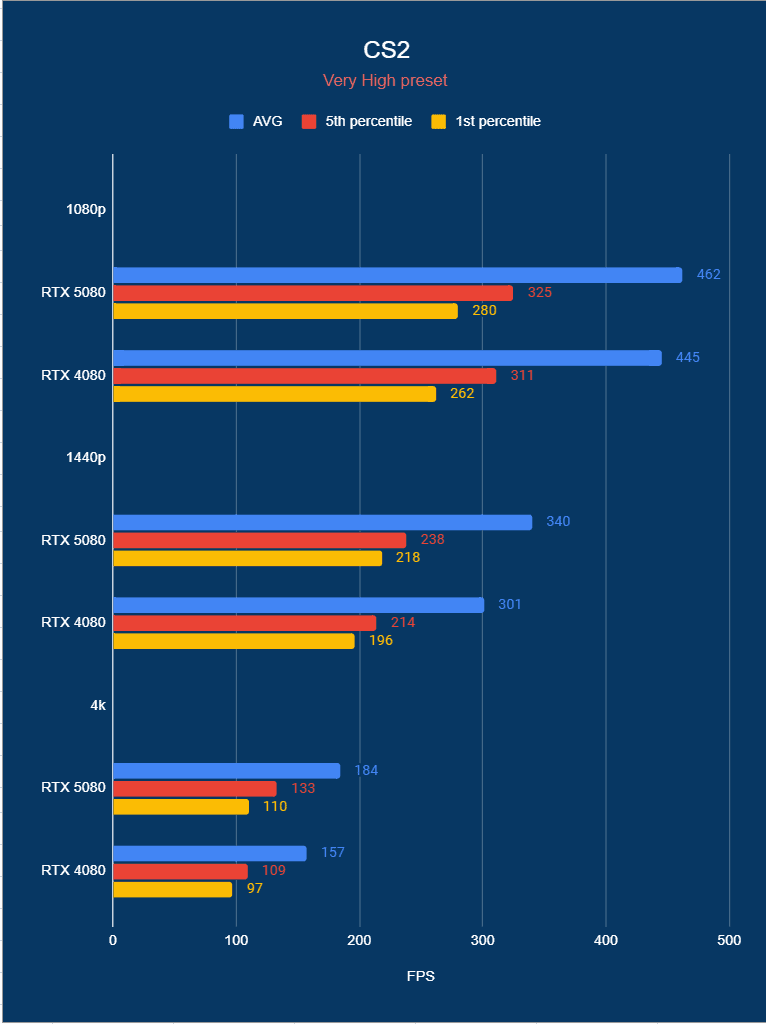

In 1440p, the gap widens further, with the RTX 5080 producing an average of 343 FPS, a significant jump over the RTX 4080’s 303 FPS. The 5080 ensures minimal drops even under demanding conditions, holding firm at 240 FPS in the 5th percentile and 220 FPS in the 1st. By comparison, the 4080 lags slightly behind with 216 and 198 FPS in those categories, which, while still excellent, lacks the same stability assurance.
The difference becomes even more pronounced at 4K, where the RTX 5080 holds a commanding 17% lead over the RTX 4080 in average performance, hitting 186 FPS to the 4080’s 159 FPS. While both GPUs remain highly capable, the 5080’s frame rates in the 5th and 1st percentiles (135 and 112 FPS, respectively) ensure a smoother experience in competitive 4K gameplay. By contrast, the 4080 dips to 111 and 98 FPS, which, while decent, highlights its limitations in handling ultra-high resolutions with the same finesse as the newer card.
Cyberpunk 2077 performance
Cyberpunk 2077 remains one of the most challenging games to run, and the RTX 5080 handles it confidently, especially at higher resolutions. At 1080p, the RTX 5080 averages 213 FPS, slightly ahead of the RTX 4080’s 201 FPS, with tighter 1% and 5% percentile values ensuring fewer frame drops. This lead becomes far more pronounced at 1440p, where the RTX 5080’s 151 FPS average surpasses the RTX 4080’s 126 FPS, reflecting the generational leap in raw performance and efficiency. At 4K, the RTX 5080 achieves 72 FPS on average, compared to the RTX 4080’s 57 FPS, representing a 26% improvement, enough to make native 4K gaming far more viable without relying heavily on upscaling.
Previous
Next
With ray tracing enabled, the RTX 5080 continues to excel, delivering higher averages across the board. For example, at 4K with ray tracing and DLSS set to Performance mode, the RTX 5080 pushes 58 FPS compared to the RTX 4080’s 54 FPS. Adding MFG into the mix at 4x scaling furthers this, skyrocketing the RTX 5080’s performance to an impressive 183 FPS at 4K. This is a huge leap, showcasing the power of multi-frame generation in smoothing out performance and bolstering frame rates in one of the most visually demanding games on the market.
Doom Eternal and AC Mirage
Doom Eternal presents an interesting case, as its performance often hinges on how well a GPU handles its Vulkan API (unless you’re a DX fan). At 1080p, the RTX 5080 trails slightly behind the RTX 4080 with an average of 503 FPS versus 521 FPS, though this difference is unlikely to be perceptible to most gamers. However, the RTX 5080 claws back some ground at higher resolutions, delivering 261 FPS at 4K, a marginal improvement over the RTX 4080’s 254 FPS. When ray tracing is enabled, the gap closes further, with both GPUs trading blows depending on the percentile metrics, though the RTX 5080 generally demonstrates slightly better consistency in 1% and 5% lows.
Previous
Next
In Assassin’s Creed Mirage, the RTX 5080 and RTX 4080 are neck-and-neck at 1080p and 1440p, with both GPUs averaging around 150 FPS. However, at 4K, the RTX 5080 pulls ahead slightly, delivering 106 FPS compared to the RTX 4080’s 102 FPS.
Horizon Zero Dawn Remastered and Shadow of the Tomb Raider
Horizon Zero Dawn Remastered showcases the RTX 5080’s strength in DLSS-enhanced scenarios. At 4K with DLSS Performance mode enabled, the RTX 5080 averages 149 FPS, only slightly trailing the RTX 4080’s 151 FPS. However, enabling Frame Generation allows the RTX 5080 to surge ahead, reaching an impressive 190 FPS, far outpacing the RTX 4080’s 176 FPS in the same configuration. These results highlight how the RTX 5080’s updated AI hardware and multi-frame generation features can extract additional performance, particularly in titles optimized for Nvidia’s latest technologies.
Previous
Next
Shadow of the Tomb Raider tells a similar story. At native 4K, the RTX 5080 achieves 138 FPS compared to the RTX 4080’s 126 FPS. With ray tracing enabled, the RTX 5080 maintains a consistent lead, delivering 91 FPS at 4K RT compared to the RTX 4080’s 83 FPS. Enabling DLSS Quality or Performance mode widens this gap further, with the RTX 5080 benefiting from higher bandwidth and better AI upscaling. At 1440p DLSS Balanced with ray tracing enabled, the RTX 5080 averages 243 FPS, outperforming the RTX 4080’s 216 FPS.
Star Wars Outlaws and the Power of Multi-Frame Generation
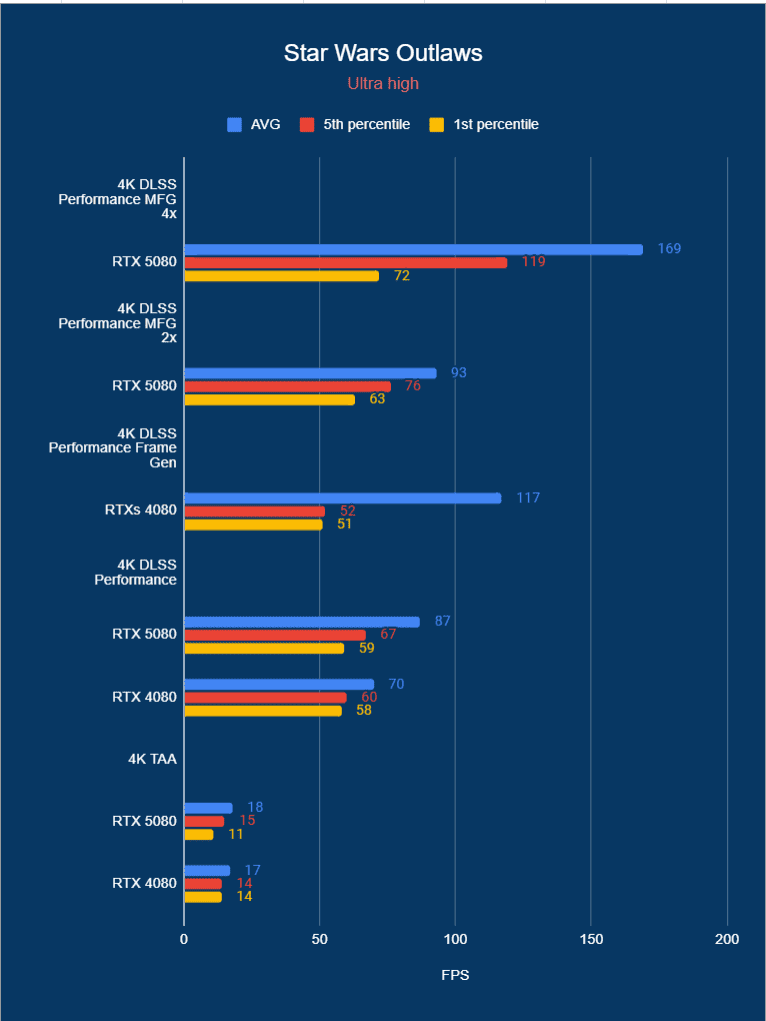

Finally, Star Wars Outlaws demonstrates the potential of multi-frame generation. At 4K with DLSS Performance and MFG 4x enabled, the RTX 5080 achieves 169 FPS on average, dwarfing the RTX 4080’s 117 FPS with Frame Generation alone. Even at MFG 2x, the RTX 5080 delivers 93 FPS, showcasing its ability to push higher frame rates in supported titles. Nvidia’s new MFG technology is clearly fantastic at pulling frames out of seemingly thin air. However, you must remember that MFG is only available on games supporting DLSS 4. If you’re used to older titles that aren’t in development, you might not benefit too much from the RTX 5080. Something to consider.
Synthetic performance
The RTX 5080 flexes its muscles in synthetic benchmarks with good generational gains, particularly in ray tracing and compute-heavy workloads. Across 3DMark tests, it consistently outperforms the RTX 4080, with Fire Strike Ultra hitting 21,558, a 34% uplift, and Time Spy Extreme reaching 16,059, marking a 24% improvement. Ray tracing performance sees an even bigger jump in Port Royal, where the 5080 scores 22,101, a 31% lead over its predecessor. Meanwhile, in Steel Nomad, a demanding path-tracing benchmark, the 5080 pushes 8,229 points, showing a 31% gain over the 4080.
Previous
Next
Compute workloads paint a similarly dominant picture. In Blender 4.3, the RTX 5080 consistently renders faster, with gains across Monster (4,453.46 vs. 4,299.35 avg FPS), Junkshop (2,329.44 vs. 2,061.35 avg FPS, +13%), and Classroom (2,269.24 vs. 2,172.71 avg FPS, +4%). Geekbench 6 further reinforces this, with the 5080 hitting 266,989 in OpenCL (+4% over the 4080) and 267,201 in Vulkan, a 22% leap.
AI acceleration also sees meaningful progress, with Geekbench AI 1.2 (DirectML) reporting notable improvements in Half Precision (60,898 vs 52,972, +15%) and Single Precision (36,533 vs 36,113, +1%), though Quantized performance remains effectively unchanged (27,989 vs 28,079).
Finally, encoding performance is strong, with Handbrake’s Tears of Steel 4K test showing slight efficiency gains. The RTX 5080 completes H.265 NVENC encoding in 1:44 with an average of 173 FPS, compared to 1:50 and 165 FPS on the 4080. Meanwhile, H.265 VCN encoding remains locked at 98 FPS for both GPUs.
Across the board, the RTX 5080’s synthetic performance highlights clear improvements in rasterisation, ray tracing, computing, and AI-driven workloads—cementing its status as a true generational leap.
Price and availability
The RTX 5080 launches with an MSRP of $999/£979, making it $200 cheaper than the original RTX 4080 while offering significantly better performance. This pricing strategy positions the RTX 5080 as a highly competitive option in the high-end GPU market. Partner cards are expected to range between $999 and $1,099, depending on custom cooling and factory overclocks.
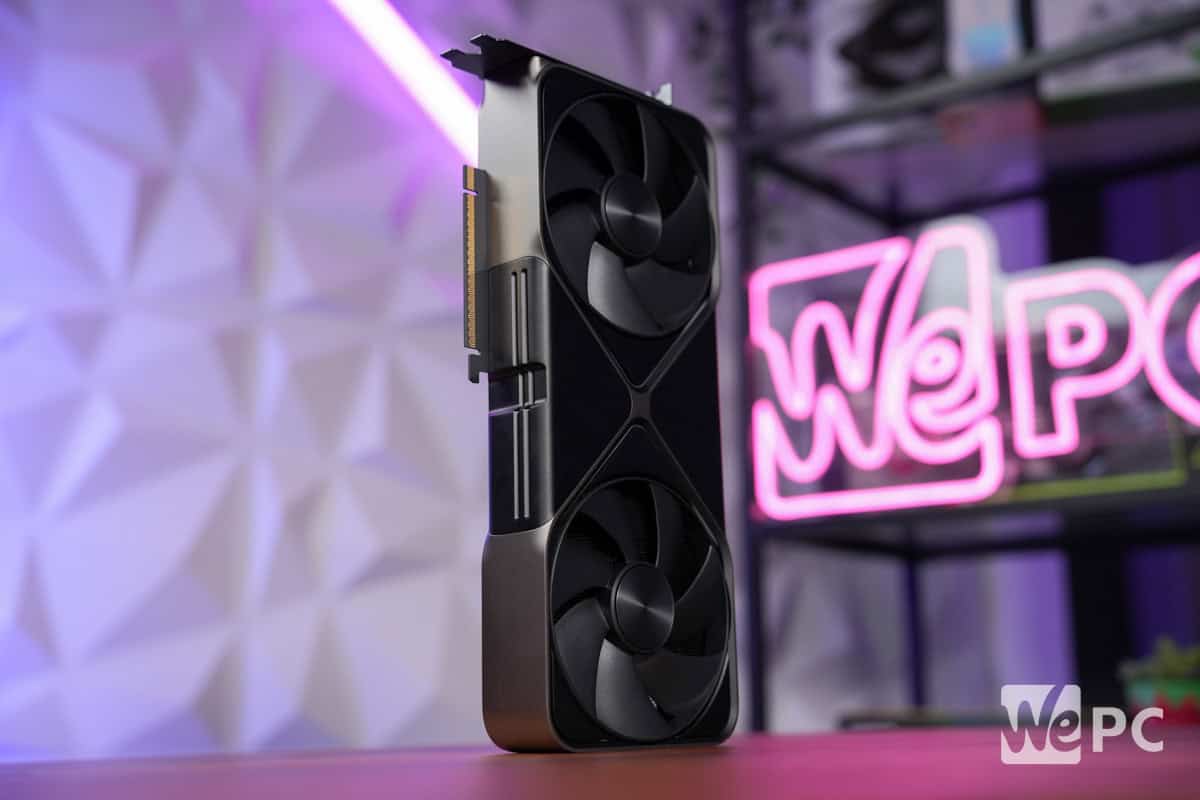

Given its price-to-performance ratio, the RTX 5080 is a clear contender for gamers and creators seeking cutting-edge technology without venturing into the ultra-premium flagship territory. However, rumours of poor availability on launch are already circulating, especially for the Founders Edition GPUs. If you want a 5080, don’t get too disheartened if you don’t manage to pick up an FE card. Other options will be available, but probably not for long.
Final word



![[2025 Upgraded] Retractable Car Charger, SUPERONE 69W Car Phone Charger with Cables Fast Charging, Gifts for Men Women Car Accessories for iPhone 16 15 14 13 12, Samsung, Black](https://i1.wp.com/m.media-amazon.com/images/I/61SaegZpsSL._AC_SL1500_.jpg?w=300&resize=300,300&ssl=1)



![[True Military-Grade] Car Phone Holder【2024 Stronger Suction & Clip】 Universal Cell Phone Holder for Car Mount for Dashboard Windshield Air Vent Long Arm Cell Phone Car Mount Thick Case,Black](https://i2.wp.com/m.media-amazon.com/images/I/715PBCuJezL._AC_SL1500_.jpg?w=300&resize=300,300&ssl=1)
![[エレコム] スマホショルダー ショルダーストラップ 肩掛け ストラップホールシート付属 丸紐 8mm P-STSDH2R08](https://i3.wp.com/m.media-amazon.com/images/I/51BMFf06pxL._AC_SL1500_.jpg?w=300&resize=300,300&ssl=1)







